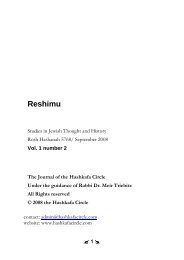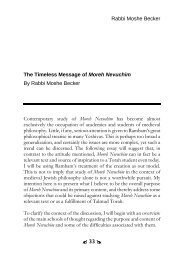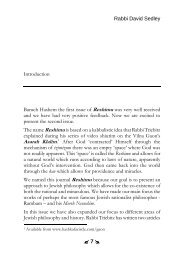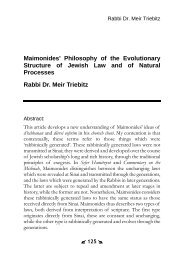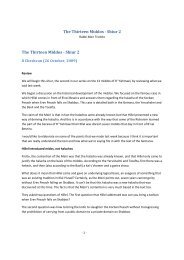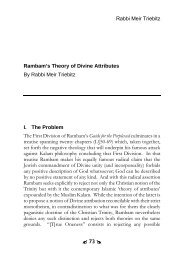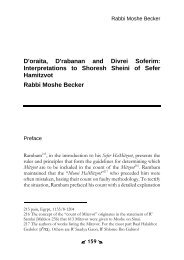Rabbi Dr Meir Triebitz 131 The Guide for the Perplexed on Creation ...
Rabbi Dr Meir Triebitz 131 The Guide for the Perplexed on Creation ...
Rabbi Dr Meir Triebitz 131 The Guide for the Perplexed on Creation ...
Create successful ePaper yourself
Turn your PDF publications into a flip-book with our unique Google optimized e-Paper software.
<str<strong>on</strong>g>The</str<strong>on</strong>g> <str<strong>on</strong>g>Guide</str<strong>on</strong>g> <str<strong>on</strong>g>for</str<strong>on</strong>g> <str<strong>on</strong>g>the</str<strong>on</strong>g> <str<strong>on</strong>g>Perplexed</str<strong>on</strong>g> <strong>on</strong> Creati<strong>on</strong><br />
Introducti<strong>on</strong><br />
By <str<strong>on</strong>g>Rabbi</str<strong>on</strong>g> <str<strong>on</strong>g>Dr</str<strong>on</strong>g>. <str<strong>on</strong>g>Meir</str<strong>on</strong>g> <str<strong>on</strong>g>Triebitz</str<strong>on</strong>g><br />
<str<strong>on</strong>g>131</str<strong>on</strong>g> <br />
<str<strong>on</strong>g>Rabbi</str<strong>on</strong>g> <str<strong>on</strong>g>Dr</str<strong>on</strong>g> <str<strong>on</strong>g>Meir</str<strong>on</strong>g> <str<strong>on</strong>g>Triebitz</str<strong>on</strong>g><br />
Since Rambam’s declarati<strong>on</strong> in his famous introducti<strong>on</strong> to <str<strong>on</strong>g>the</str<strong>on</strong>g> <str<strong>on</strong>g>Guide</str<strong>on</strong>g><br />
that he is going to deliberately c<strong>on</strong>tradict himself in order to hide<br />
secrets of <str<strong>on</strong>g>the</str<strong>on</strong>g> Torah from <str<strong>on</strong>g>the</str<strong>on</strong>g> unenlightened reader, <str<strong>on</strong>g>the</str<strong>on</strong>g> true positi<strong>on</strong><br />
of Rambam emerged as <str<strong>on</strong>g>the</str<strong>on</strong>g> ‘Holy Grail’ of virtually every<br />
commentator. As <strong>on</strong>e prominent scholar puts it, “It would be<br />
difficult to point to any o<str<strong>on</strong>g>the</str<strong>on</strong>g>r problem in <str<strong>on</strong>g>the</str<strong>on</strong>g> history of Jewish<br />
philosophy which has so absorbed scholars and fascinated <str<strong>on</strong>g>the</str<strong>on</strong>g>ir<br />
curiosity, both in <str<strong>on</strong>g>the</str<strong>on</strong>g> Middle Ages and in recent generati<strong>on</strong>s”. 201<br />
Moreover, <str<strong>on</strong>g>the</str<strong>on</strong>g> history of Maim<strong>on</strong>idean commentary frequently reads<br />
like a virtual intellectual history of Judaism whereby each<br />
commentator attributes to Rambam <str<strong>on</strong>g>the</str<strong>on</strong>g> philosophical vogue of his<br />
respective era. Nowhere is this more manifest than in <str<strong>on</strong>g>the</str<strong>on</strong>g> chapters of<br />
<str<strong>on</strong>g>the</str<strong>on</strong>g> <str<strong>on</strong>g>Guide</str<strong>on</strong>g> which deal with creati<strong>on</strong>. Rambam’s discussi<strong>on</strong> of this<br />
central issue is replete with all types of c<strong>on</strong>tradicti<strong>on</strong>s, vague<br />
statements and various sorts of innuendos, all of which were<br />
201 Ravitsky, ‘<str<strong>on</strong>g>The</str<strong>on</strong>g> Secrets of Maim<strong>on</strong>ides between <str<strong>on</strong>g>the</str<strong>on</strong>g> 13 th and 20 th Centuries’
<str<strong>on</strong>g>The</str<strong>on</strong>g> <str<strong>on</strong>g>Guide</str<strong>on</strong>g> <str<strong>on</strong>g>for</str<strong>on</strong>g> <str<strong>on</strong>g>the</str<strong>on</strong>g> <str<strong>on</strong>g>Perplexed</str<strong>on</strong>g> <strong>on</strong> Creati<strong>on</strong> – Introducti<strong>on</strong><br />
meticulously picked up by <str<strong>on</strong>g>the</str<strong>on</strong>g> various commentators. Major Medieval<br />
commentators, such as Ibn Tib<strong>on</strong>, Moshe Narb<strong>on</strong>i and Ibn Kaspi<br />
were of <str<strong>on</strong>g>the</str<strong>on</strong>g> opini<strong>on</strong> that although Rambam states clearly that <str<strong>on</strong>g>the</str<strong>on</strong>g><br />
positi<strong>on</strong> of <str<strong>on</strong>g>the</str<strong>on</strong>g> Torah is that God created <str<strong>on</strong>g>the</str<strong>on</strong>g> world ex nihilo, he was<br />
in secret, an Aristotelian who believed in <str<strong>on</strong>g>the</str<strong>on</strong>g> eternity of <str<strong>on</strong>g>the</str<strong>on</strong>g> universe.<br />
<str<strong>on</strong>g>The</str<strong>on</strong>g>se Medieval philosophers felt that <str<strong>on</strong>g>the</str<strong>on</strong>g> <str<strong>on</strong>g>Guide</str<strong>on</strong>g> was intended to<br />
dem<strong>on</strong>strate how <str<strong>on</strong>g>the</str<strong>on</strong>g> truths of <str<strong>on</strong>g>the</str<strong>on</strong>g> Torah reduced to those of Greek<br />
philosophy. In modern times, scholars such as Shadal, Pines and<br />
Strauss were of <str<strong>on</strong>g>the</str<strong>on</strong>g> opini<strong>on</strong> that Rambam’s hidden message is that<br />
Judaism cannot be rec<strong>on</strong>ciled with philosophy. While <str<strong>on</strong>g>the</str<strong>on</strong>g> minds of<br />
<str<strong>on</strong>g>the</str<strong>on</strong>g> masses are put to rest that <str<strong>on</strong>g>the</str<strong>on</strong>g> c<strong>on</strong>tradicti<strong>on</strong>s between philosophy<br />
and Torah can be resolved, <str<strong>on</strong>g>the</str<strong>on</strong>g> true positi<strong>on</strong> of Rambam is that <strong>on</strong>e<br />
cannot be both a believing Jew and admit to <str<strong>on</strong>g>the</str<strong>on</strong>g> truth of Greek<br />
thought. In essence, both <str<strong>on</strong>g>for</str<strong>on</strong>g>ms of interpretati<strong>on</strong>s are n<strong>on</strong>e o<str<strong>on</strong>g>the</str<strong>on</strong>g>r<br />
than descripti<strong>on</strong>s of <str<strong>on</strong>g>the</str<strong>on</strong>g> positi<strong>on</strong> of <str<strong>on</strong>g>the</str<strong>on</strong>g> interpreters <str<strong>on</strong>g>the</str<strong>on</strong>g>mselves. Ibn<br />
Kaspi, Ibn Tib<strong>on</strong> and Narb<strong>on</strong>i were religious Jews who believed in<br />
<str<strong>on</strong>g>the</str<strong>on</strong>g> truth of Greek philosophy and that this truth could be resolved<br />
with <str<strong>on</strong>g>the</str<strong>on</strong>g> religious truth of <str<strong>on</strong>g>the</str<strong>on</strong>g> Torah. Strauss and Pines, <strong>on</strong> <str<strong>on</strong>g>the</str<strong>on</strong>g> o<str<strong>on</strong>g>the</str<strong>on</strong>g>r<br />
hand, were secular Jews who no doubt believed that <str<strong>on</strong>g>the</str<strong>on</strong>g> Torah has<br />
no relevance to <str<strong>on</strong>g>the</str<strong>on</strong>g> modern c<strong>on</strong>cepti<strong>on</strong> of truth.<br />
For <str<strong>on</strong>g>the</str<strong>on</strong>g> ‘medieval commentators of c<strong>on</strong>tradicti<strong>on</strong>’ 202 <str<strong>on</strong>g>the</str<strong>on</strong>g> purpose of<br />
c<strong>on</strong>tradicti<strong>on</strong> in <str<strong>on</strong>g>the</str<strong>on</strong>g> <str<strong>on</strong>g>Guide</str<strong>on</strong>g> is to distinguish ‘revealed truth’ from a<br />
‘hidden truth’. For <str<strong>on</strong>g>the</str<strong>on</strong>g>m, <str<strong>on</strong>g>the</str<strong>on</strong>g> ‘revealed truth’ of <str<strong>on</strong>g>the</str<strong>on</strong>g> Torah, based<br />
up<strong>on</strong> traditi<strong>on</strong> and prophetic revelati<strong>on</strong>, is coming to exclude <str<strong>on</strong>g>the</str<strong>on</strong>g><br />
sacrilegious beliefs of <str<strong>on</strong>g>the</str<strong>on</strong>g> philosophers. <str<strong>on</strong>g>The</str<strong>on</strong>g> ‘hidden truth’ is that<br />
Greek philosophy c<strong>on</strong>stitutes <str<strong>on</strong>g>the</str<strong>on</strong>g> hidden teaching of <str<strong>on</strong>g>the</str<strong>on</strong>g> Torah.<br />
Hence <str<strong>on</strong>g>the</str<strong>on</strong>g> two truths are in fact rec<strong>on</strong>cilable. For <str<strong>on</strong>g>the</str<strong>on</strong>g> modern<br />
commentators 203 , c<strong>on</strong>tradicti<strong>on</strong>s are coming simply to distinguish<br />
between false asserti<strong>on</strong>s and true asserti<strong>on</strong>s. As Strauss writes in his<br />
essay ‘<str<strong>on</strong>g>the</str<strong>on</strong>g> Literary Character of <str<strong>on</strong>g>the</str<strong>on</strong>g> <str<strong>on</strong>g>Guide</str<strong>on</strong>g> <str<strong>on</strong>g>for</str<strong>on</strong>g> <str<strong>on</strong>g>the</str<strong>on</strong>g> <str<strong>on</strong>g>Perplexed</str<strong>on</strong>g>’:<br />
202 i.e. Kaspi, Ibn Tib<strong>on</strong> and Narb<strong>on</strong>i<br />
203 such as Pines and Strauss<br />
132
133 <br />
<str<strong>on</strong>g>Rabbi</str<strong>on</strong>g> <str<strong>on</strong>g>Dr</str<strong>on</strong>g> <str<strong>on</strong>g>Meir</str<strong>on</strong>g> <str<strong>on</strong>g>Triebitz</str<strong>on</strong>g><br />
<str<strong>on</strong>g>The</str<strong>on</strong>g> duty of <str<strong>on</strong>g>the</str<strong>on</strong>g> interpreter is not to explain <str<strong>on</strong>g>the</str<strong>on</strong>g><br />
c<strong>on</strong>tradicti<strong>on</strong>s but to find out in each case which of <str<strong>on</strong>g>the</str<strong>on</strong>g> two<br />
statements was c<strong>on</strong>sidered by Maim<strong>on</strong>ides to be true and<br />
which he merely used as a means of hiding <str<strong>on</strong>g>the</str<strong>on</strong>g> truth. 204<br />
Fur<str<strong>on</strong>g>the</str<strong>on</strong>g>r <strong>on</strong> in <str<strong>on</strong>g>the</str<strong>on</strong>g> same essay, Strauss writes that:<br />
All important c<strong>on</strong>tradicti<strong>on</strong>s in <str<strong>on</strong>g>the</str<strong>on</strong>g> <str<strong>on</strong>g>Guide</str<strong>on</strong>g> may be reduced to<br />
<str<strong>on</strong>g>the</str<strong>on</strong>g> single fundamental c<strong>on</strong>tradicti<strong>on</strong> between <str<strong>on</strong>g>the</str<strong>on</strong>g> true<br />
teaching based <strong>on</strong> reas<strong>on</strong>, and <str<strong>on</strong>g>the</str<strong>on</strong>g> untrue teaching, emanating<br />
from imaginati<strong>on</strong>. 205<br />
<str<strong>on</strong>g>The</str<strong>on</strong>g> assumpti<strong>on</strong> of Strauss, that <str<strong>on</strong>g>the</str<strong>on</strong>g> c<strong>on</strong>tradicti<strong>on</strong>s of <str<strong>on</strong>g>the</str<strong>on</strong>g> <str<strong>on</strong>g>Guide</str<strong>on</strong>g> are to<br />
distinguish truth from falsehood, must be questi<strong>on</strong>ed and brought to<br />
task. Let us look at <str<strong>on</strong>g>the</str<strong>on</strong>g> crucial passage in <str<strong>on</strong>g>the</str<strong>on</strong>g> Introducti<strong>on</strong> which is<br />
<str<strong>on</strong>g>the</str<strong>on</strong>g> source of all <str<strong>on</strong>g>the</str<strong>on</strong>g> c<strong>on</strong>troversy.<br />
<str<strong>on</strong>g>The</str<strong>on</strong>g> seventh reas<strong>on</strong> [<str<strong>on</strong>g>for</str<strong>on</strong>g> c<strong>on</strong>tradicti<strong>on</strong>] arises from <str<strong>on</strong>g>the</str<strong>on</strong>g><br />
necessity to discuss very deep issues which must be partly<br />
revealed and partly hidden. Sometimes it is necessary <strong>on</strong> <str<strong>on</strong>g>the</str<strong>on</strong>g><br />
basis of certain statements to understand <str<strong>on</strong>g>the</str<strong>on</strong>g>se issues based<br />
up<strong>on</strong> a certain a priori assumpti<strong>on</strong>, and sometimes it is<br />
necessary to understand <str<strong>on</strong>g>the</str<strong>on</strong>g> issue based up<strong>on</strong> a c<strong>on</strong>tradictory<br />
a priori assumpti<strong>on</strong>. It is important that <str<strong>on</strong>g>the</str<strong>on</strong>g> masses not be<br />
aware in any way of <str<strong>on</strong>g>the</str<strong>on</strong>g> c<strong>on</strong>tradicti<strong>on</strong>. <str<strong>on</strong>g>The</str<strong>on</strong>g> author must take<br />
every precauti<strong>on</strong> to hide <str<strong>on</strong>g>the</str<strong>on</strong>g> c<strong>on</strong>tradicti<strong>on</strong> 206 .<br />
Rambam is not claiming that having two c<strong>on</strong>tradictory premises<br />
necessarily implies that <strong>on</strong>e is true and <str<strong>on</strong>g>the</str<strong>on</strong>g> o<str<strong>on</strong>g>the</str<strong>on</strong>g>r is false. He is simply<br />
stating that certain issues are of such orders of complexity that <str<strong>on</strong>g>the</str<strong>on</strong>g>y<br />
cannot be understood completely <strong>on</strong> <str<strong>on</strong>g>the</str<strong>on</strong>g> basis of <str<strong>on</strong>g>the</str<strong>on</strong>g> set of selfc<strong>on</strong>sistent<br />
assumpti<strong>on</strong>s. It may be that two assumpti<strong>on</strong>s are both<br />
true, relative to different perspectives. <str<strong>on</strong>g>The</str<strong>on</strong>g> reas<strong>on</strong> that <str<strong>on</strong>g>the</str<strong>on</strong>g> masses<br />
204 Persecuti<strong>on</strong> and <str<strong>on</strong>g>the</str<strong>on</strong>g> Art of Writing p. 69<br />
205 ibid. p. 73<br />
206 Introducti<strong>on</strong> to <str<strong>on</strong>g>the</str<strong>on</strong>g> <str<strong>on</strong>g>Guide</str<strong>on</strong>g> Schwartz ed. p 22. authors translati<strong>on</strong>.
<str<strong>on</strong>g>The</str<strong>on</strong>g> <str<strong>on</strong>g>Guide</str<strong>on</strong>g> <str<strong>on</strong>g>for</str<strong>on</strong>g> <str<strong>on</strong>g>the</str<strong>on</strong>g> <str<strong>on</strong>g>Perplexed</str<strong>on</strong>g> <strong>on</strong> Creati<strong>on</strong> – Introducti<strong>on</strong><br />
must be protected from awareness of such c<strong>on</strong>tradicti<strong>on</strong>s might<br />
simply be because <str<strong>on</strong>g>the</str<strong>on</strong>g>y lack <str<strong>on</strong>g>the</str<strong>on</strong>g> sophisticati<strong>on</strong> of thought to accept<br />
such truths. As a result, <str<strong>on</strong>g>the</str<strong>on</strong>g>y might come to reject <str<strong>on</strong>g>the</str<strong>on</strong>g> entire belief<br />
because of its lack of clarity and precisi<strong>on</strong>. It is <str<strong>on</strong>g>for</str<strong>on</strong>g> this reas<strong>on</strong> that<br />
Rambam writes in chapter 26 of secti<strong>on</strong> I that <str<strong>on</strong>g>the</str<strong>on</strong>g> Bible employed<br />
anthropomorphic images of God. <str<strong>on</strong>g>The</str<strong>on</strong>g> philosophical noti<strong>on</strong> of<br />
m<strong>on</strong>o<str<strong>on</strong>g>the</str<strong>on</strong>g>ism and Divine incorporality would have seemed<br />
incomprehensible to <str<strong>on</strong>g>the</str<strong>on</strong>g> uneducated and drive <str<strong>on</strong>g>the</str<strong>on</strong>g>m towards a<str<strong>on</strong>g>the</str<strong>on</strong>g>ism.<br />
For most people, <str<strong>on</strong>g>the</str<strong>on</strong>g>ological issues must be presented and thought of<br />
in black and white terms. Only sophisticated minds can appreciate<br />
irreducible dichotomies and multi-layered depths. C<strong>on</strong>tradicti<strong>on</strong>s <str<strong>on</strong>g>for</str<strong>on</strong>g><br />
Rambam are natural c<strong>on</strong>sequences of <str<strong>on</strong>g>the</str<strong>on</strong>g> exceedingly difficult and<br />
ultimately impossible task of comprehending Divine truths. <str<strong>on</strong>g>The</str<strong>on</strong>g><br />
masses, however, must not be made aware of <str<strong>on</strong>g>the</str<strong>on</strong>g>se c<strong>on</strong>tradicti<strong>on</strong>s<br />
because it will <strong>on</strong>ly c<strong>on</strong>fuse <str<strong>on</strong>g>the</str<strong>on</strong>g>m and c<strong>on</strong>vince <str<strong>on</strong>g>the</str<strong>on</strong>g>m of <str<strong>on</strong>g>the</str<strong>on</strong>g> futility of<br />
<str<strong>on</strong>g>the</str<strong>on</strong>g> whole enterprise.<br />
If we return to <str<strong>on</strong>g>the</str<strong>on</strong>g> issue of creati<strong>on</strong>, we find clear evidence that <str<strong>on</strong>g>the</str<strong>on</strong>g><br />
c<strong>on</strong>tradicti<strong>on</strong>s to be found in Rambam’s discussi<strong>on</strong> of <str<strong>on</strong>g>the</str<strong>on</strong>g> eternity of<br />
<str<strong>on</strong>g>the</str<strong>on</strong>g> world versus creati<strong>on</strong> ex nihilo cannot possibly be understood as<br />
implying that <strong>on</strong>e positi<strong>on</strong> of <str<strong>on</strong>g>the</str<strong>on</strong>g> two is true and <str<strong>on</strong>g>the</str<strong>on</strong>g> o<str<strong>on</strong>g>the</str<strong>on</strong>g>r false. At<br />
<str<strong>on</strong>g>the</str<strong>on</strong>g> end of chapter 30 of secti<strong>on</strong> II Rambam states that <str<strong>on</strong>g>the</str<strong>on</strong>g>re are four<br />
words which are used in Scripture to c<strong>on</strong>note Divine creati<strong>on</strong>; Barah<br />
(ארב); Assah (השע); Kannah (הנק) and Kel ( ל -א).<br />
Barah refers to<br />
creati<strong>on</strong> ex nihilo (ןיאמ שי האירב). Assah refers to <str<strong>on</strong>g>the</str<strong>on</strong>g> creati<strong>on</strong> of <str<strong>on</strong>g>the</str<strong>on</strong>g><br />
particular <str<strong>on</strong>g>for</str<strong>on</strong>g>ms of things, while Kel refers to God’s perfecti<strong>on</strong> in<br />
comparis<strong>on</strong> to His creati<strong>on</strong>. When he explains <str<strong>on</strong>g>the</str<strong>on</strong>g> meaning of <str<strong>on</strong>g>the</str<strong>on</strong>g><br />
term Kannah Rambam writes:<br />
It says Kannah (literally ‘possess’) because He, may He be<br />
exalted, has domini<strong>on</strong> over <str<strong>on</strong>g>the</str<strong>on</strong>g>m (His creati<strong>on</strong>s) just as a<br />
master has over his slaves. For this reas<strong>on</strong> He is also called<br />
‘<str<strong>on</strong>g>The</str<strong>on</strong>g> Lord of all <str<strong>on</strong>g>the</str<strong>on</strong>g> earth’ (Joshua 3: 11 and 13) and <str<strong>on</strong>g>the</str<strong>on</strong>g> Lord<br />
(Exodus 23: 17, 34: 23). However, as <str<strong>on</strong>g>the</str<strong>on</strong>g>re is no Lord<br />
134
135 <br />
<str<strong>on</strong>g>Rabbi</str<strong>on</strong>g> <str<strong>on</strong>g>Dr</str<strong>on</strong>g> <str<strong>on</strong>g>Meir</str<strong>on</strong>g> <str<strong>on</strong>g>Triebitz</str<strong>on</strong>g><br />
without <str<strong>on</strong>g>the</str<strong>on</strong>g>re being something possessed by Him, and this<br />
tends toward <str<strong>on</strong>g>the</str<strong>on</strong>g> road of <str<strong>on</strong>g>the</str<strong>on</strong>g> belief in <str<strong>on</strong>g>the</str<strong>on</strong>g> eternity of a certain<br />
matter…” (secti<strong>on</strong> II chapter 30).<br />
We see clearly, <str<strong>on</strong>g>the</str<strong>on</strong>g>n, that Rambam understood that <str<strong>on</strong>g>the</str<strong>on</strong>g>re are<br />
c<strong>on</strong>tradictory terms in Scripture itself with respect to<br />
creati<strong>on</strong>. Kannah implies <str<strong>on</strong>g>the</str<strong>on</strong>g> eternity of creati<strong>on</strong>, whereas<br />
Barah is creati<strong>on</strong> ex nihilo. Now Rambam has in<str<strong>on</strong>g>for</str<strong>on</strong>g>med us in<br />
his introducti<strong>on</strong> that c<strong>on</strong>tradicti<strong>on</strong>s in <str<strong>on</strong>g>the</str<strong>on</strong>g> prophetic<br />
Scriptures are ei<str<strong>on</strong>g>the</str<strong>on</strong>g>r due to <str<strong>on</strong>g>the</str<strong>on</strong>g> third reas<strong>on</strong>, namely that <strong>on</strong>e<br />
verse is literal and <strong>on</strong>e figurative, or due to <str<strong>on</strong>g>the</str<strong>on</strong>g> fourth reas<strong>on</strong>,<br />
that ei<str<strong>on</strong>g>the</str<strong>on</strong>g>r a stipulati<strong>on</strong> which cannot be made in <strong>on</strong>e verse is<br />
placed in <str<strong>on</strong>g>the</str<strong>on</strong>g> o<str<strong>on</strong>g>the</str<strong>on</strong>g>r, or that <str<strong>on</strong>g>the</str<strong>on</strong>g> topics are different in <str<strong>on</strong>g>the</str<strong>on</strong>g><br />
different places, giving <str<strong>on</strong>g>the</str<strong>on</strong>g> appearance that <str<strong>on</strong>g>the</str<strong>on</strong>g> two verses<br />
c<strong>on</strong>tradict each o<str<strong>on</strong>g>the</str<strong>on</strong>g>r, although <str<strong>on</strong>g>the</str<strong>on</strong>g>re is really no<br />
c<strong>on</strong>tradicti<strong>on</strong>. Since Divine possessi<strong>on</strong> is clearly not a<br />
metaphor, we would have to c<strong>on</strong>clude that <str<strong>on</strong>g>the</str<strong>on</strong>g> c<strong>on</strong>tradicti<strong>on</strong><br />
between Barah and Kannah is <strong>on</strong>ly apparent. We <str<strong>on</strong>g>the</str<strong>on</strong>g>n are<br />
<str<strong>on</strong>g>for</str<strong>on</strong>g>ced to c<strong>on</strong>clude, as I have already indicated, that <str<strong>on</strong>g>the</str<strong>on</strong>g><br />
c<strong>on</strong>tradicti<strong>on</strong>s to be found in <str<strong>on</strong>g>the</str<strong>on</strong>g> <str<strong>on</strong>g>Guide</str<strong>on</strong>g> between <str<strong>on</strong>g>the</str<strong>on</strong>g> positi<strong>on</strong><br />
of eternity and <str<strong>on</strong>g>the</str<strong>on</strong>g> positi<strong>on</strong> of creati<strong>on</strong> ex nihilo were not<br />
regarded by Rambam to be c<strong>on</strong>tradictory, but ra<str<strong>on</strong>g>the</str<strong>on</strong>g>r reflected<br />
different aspects of viewpoints of our understanding of<br />
God’s relati<strong>on</strong>ship to <str<strong>on</strong>g>the</str<strong>on</strong>g> creati<strong>on</strong>. Rambam, <str<strong>on</strong>g>the</str<strong>on</strong>g>re<str<strong>on</strong>g>for</str<strong>on</strong>g>e,<br />
clearly saw creati<strong>on</strong> ex nihilo and eternity as <strong>on</strong>ly apparently<br />
c<strong>on</strong>tradictory but not mutually exclusive.<br />
It is instructive to note where <str<strong>on</strong>g>the</str<strong>on</strong>g> above passage explicating<br />
<str<strong>on</strong>g>the</str<strong>on</strong>g> four Scriptural terms <str<strong>on</strong>g>for</str<strong>on</strong>g> creati<strong>on</strong> appears. In <str<strong>on</strong>g>the</str<strong>on</strong>g><br />
beginning of chapter 30, Rambam presents <str<strong>on</strong>g>the</str<strong>on</strong>g> clear positi<strong>on</strong><br />
of <str<strong>on</strong>g>the</str<strong>on</strong>g> Torah, that God created <str<strong>on</strong>g>the</str<strong>on</strong>g> world from nothing. He<br />
<str<strong>on</strong>g>the</str<strong>on</strong>g>n goes <strong>on</strong> to write that various statements to be found in<br />
<str<strong>on</strong>g>the</str<strong>on</strong>g> Sages which speak about <str<strong>on</strong>g>the</str<strong>on</strong>g> existence of time or o<str<strong>on</strong>g>the</str<strong>on</strong>g>r<br />
worlds be<str<strong>on</strong>g>for</str<strong>on</strong>g>e <str<strong>on</strong>g>the</str<strong>on</strong>g> account of creati<strong>on</strong> in <str<strong>on</strong>g>the</str<strong>on</strong>g> Bible are to be<br />
ignored <str<strong>on</strong>g>for</str<strong>on</strong>g> <str<strong>on</strong>g>the</str<strong>on</strong>g>y are based up<strong>on</strong> <str<strong>on</strong>g>the</str<strong>on</strong>g> Greek philosophy of
<str<strong>on</strong>g>The</str<strong>on</strong>g> <str<strong>on</strong>g>Guide</str<strong>on</strong>g> <str<strong>on</strong>g>for</str<strong>on</strong>g> <str<strong>on</strong>g>the</str<strong>on</strong>g> <str<strong>on</strong>g>Perplexed</str<strong>on</strong>g> <strong>on</strong> Creati<strong>on</strong> – Introducti<strong>on</strong><br />
eternity, which <str<strong>on</strong>g>the</str<strong>on</strong>g> Torah rejects. After a lengthy chapter in<br />
which Rambam offers a combinati<strong>on</strong> of literal and<br />
philosophical interpretati<strong>on</strong>s of <str<strong>on</strong>g>the</str<strong>on</strong>g> opening two chapters of<br />
Genesis, he c<strong>on</strong>cludes, without any seeming <str<strong>on</strong>g>the</str<strong>on</strong>g>matic<br />
c<strong>on</strong>tinuity, with <str<strong>on</strong>g>the</str<strong>on</strong>g> discussi<strong>on</strong> of Biblical terms denoting<br />
creati<strong>on</strong>. <str<strong>on</strong>g>The</str<strong>on</strong>g> statement that Barah “tends” to eternity is<br />
stated almost paren<str<strong>on</strong>g>the</str<strong>on</strong>g>tically without any c<strong>on</strong>necti<strong>on</strong> to <str<strong>on</strong>g>the</str<strong>on</strong>g><br />
discussi<strong>on</strong> at hand. Clearly this is an apparent c<strong>on</strong>tradicti<strong>on</strong><br />
which Rambam might have felt would go unnoticed except<br />
<str<strong>on</strong>g>for</str<strong>on</strong>g> <str<strong>on</strong>g>the</str<strong>on</strong>g> most alert reader.<br />
Rambam’s positi<strong>on</strong> that <str<strong>on</strong>g>the</str<strong>on</strong>g> two c<strong>on</strong>tradictory beliefs in<br />
creati<strong>on</strong> ex nihilo and eternity must both be maintained<br />
requires explanati<strong>on</strong>. It must be that <str<strong>on</strong>g>the</str<strong>on</strong>g>se two <str<strong>on</strong>g>the</str<strong>on</strong>g>ories are<br />
<str<strong>on</strong>g>the</str<strong>on</strong>g>mselves c<strong>on</strong>sequences (or necessary requirements) of two<br />
philosophical positi<strong>on</strong>s which Rambam himself felt cannot<br />
both be dispensed with. In chapter 25 of secti<strong>on</strong> II, Rambam<br />
regards creati<strong>on</strong> ex nihilo as essential <str<strong>on</strong>g>for</str<strong>on</strong>g> <str<strong>on</strong>g>the</str<strong>on</strong>g> possibility of<br />
miracles, <str<strong>on</strong>g>the</str<strong>on</strong>g> selecti<strong>on</strong> of <str<strong>on</strong>g>the</str<strong>on</strong>g> Jewish people, <str<strong>on</strong>g>the</str<strong>on</strong>g> privileging of<br />
prophets and <str<strong>on</strong>g>the</str<strong>on</strong>g> giving of <str<strong>on</strong>g>the</str<strong>on</strong>g> Torah. On <str<strong>on</strong>g>the</str<strong>on</strong>g> o<str<strong>on</strong>g>the</str<strong>on</strong>g>r hand, in<br />
chapter 1 of secti<strong>on</strong> II, <str<strong>on</strong>g>the</str<strong>on</strong>g> eternity of <str<strong>on</strong>g>the</str<strong>on</strong>g> universe is an<br />
axiom used in his proof of God’s n<strong>on</strong>-corporeality and is<br />
explicitly listed as <str<strong>on</strong>g>the</str<strong>on</strong>g> twenty sixth axiom in his introducti<strong>on</strong><br />
to <str<strong>on</strong>g>the</str<strong>on</strong>g> secti<strong>on</strong>. Clearly, <str<strong>on</strong>g>the</str<strong>on</strong>g>n, eternity of <str<strong>on</strong>g>the</str<strong>on</strong>g> universe was<br />
essential to maintain m<strong>on</strong>o<str<strong>on</strong>g>the</str<strong>on</strong>g>ism. God’s free will (and hence<br />
man’s free will) and incorporeality are <str<strong>on</strong>g>the</str<strong>on</strong>g> two pillars of <str<strong>on</strong>g>the</str<strong>on</strong>g><br />
<str<strong>on</strong>g>Guide</str<strong>on</strong>g> and Maim<strong>on</strong>idean thought in general. <str<strong>on</strong>g>The</str<strong>on</strong>g> problem is<br />
that <str<strong>on</strong>g>the</str<strong>on</strong>g>se two beliefs lead to two c<strong>on</strong>tradictory <str<strong>on</strong>g>the</str<strong>on</strong>g>ories of<br />
creati<strong>on</strong>. This is <str<strong>on</strong>g>the</str<strong>on</strong>g> central philosophical problem which<br />
faced Rambam and he dealt with it through his method of<br />
c<strong>on</strong>tradicti<strong>on</strong>.<br />
136



